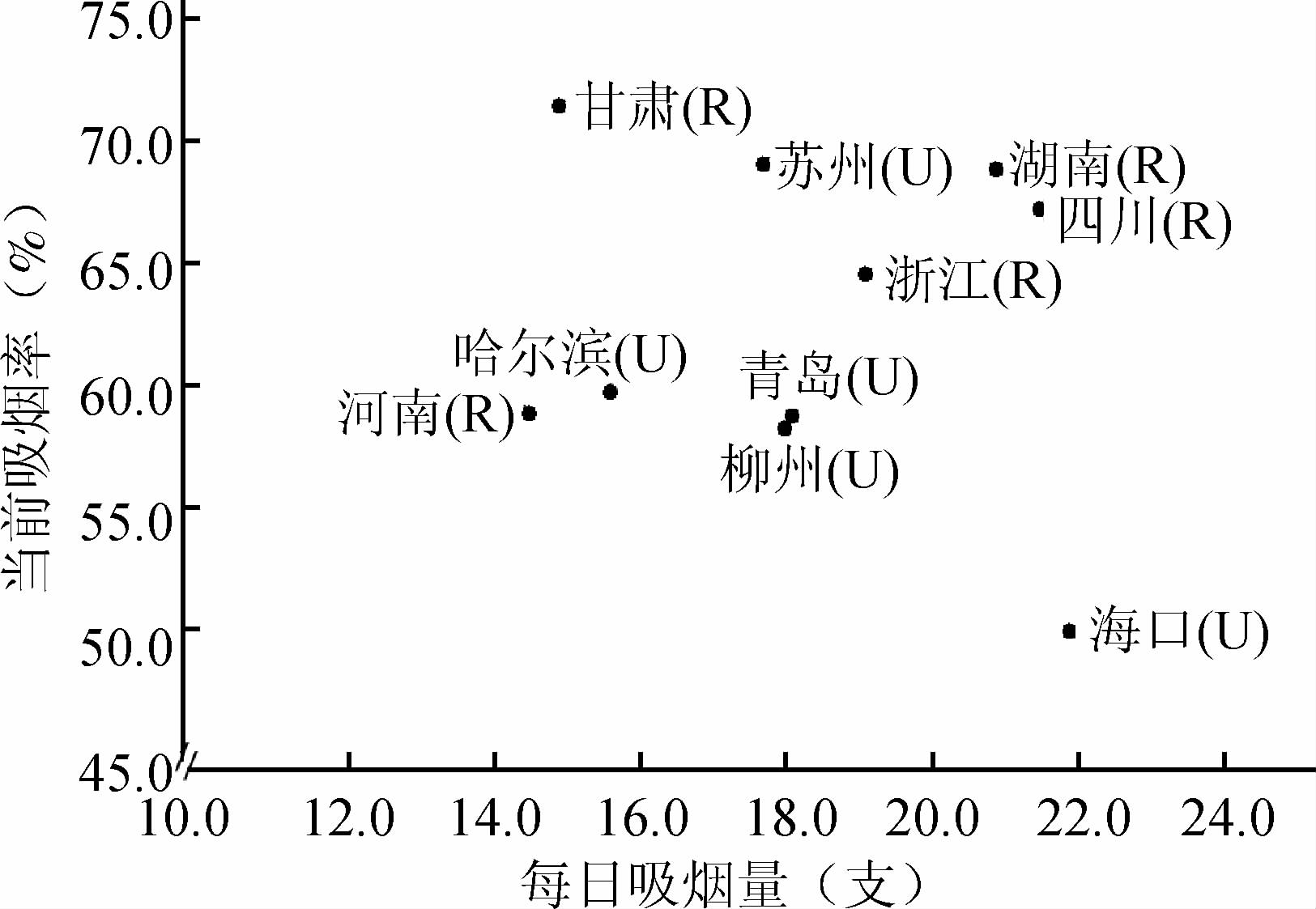文章信息
- 王昕, 吕筠, 郭彧, 卞铮, 余灿清, 周汇燕, 谭云龙, 裴培, 陈君石, 陈铮鸣, 李立明.
- Wang Xin, Lyu Jun, Guo Yu, Bian Zheng, Yu Canqing, Zhou Huiyan, Tan Yunlong, Pei Pei, Chen Junshi, Chen Zhengming, Li Liming.
- 中国慢性病前瞻性研究:10个项目地区成年人群吸烟行为特征差异分析
- Regional differences in adults' smoking pattern: findings from China Kadoorie Biobank study in 10 areas in China
- 中华流行病学杂志, 2015, 36(11): 1200-1204
- Chinese Journal of Epidemiology, 2015, 36(11): 1200-1204
- http://dx.doi.org/10.3760/cma.j.issn.0254-6450.2015.11.004
-
文章历史
- 投稿日期: 2015-07-22
2. 中国医学科学院;
3. 国家食品安全风险评估中心;
4. 英国牛津大学临床流行病学研究中心
2. Chinese Academy of Medical Sciences;
3. National Center for Food Safety Risk Assessment of China;
4. Clinical Trial Service Unit and Epidemiological Studies Unit (CTSU), Nuffield Department of Population Health, University of Oxford, UK
吸烟是心血管病、肿瘤和慢性呼吸系统疾病等众多慢性病的危险因素[1, 2, 3]。研究显示,吸烟行为的许多特征,如开始吸烟年龄、每日吸烟量、累积吸烟时间、吸入深度、吸食品种等与健康效应有关[4]。本研究旨在利用中国慢性病前瞻性研究(China Kadoorie Biobank,CKB)项目的基线调查数据描述10个项目地区成年人群在吸烟行为特征上的地区差异。
对象与方法1. 研究对象:源自CKB的10个(城乡各5个)项目地区基线数据(2004-2008年)[5, 6, 7],并将512 891名有完整基线调查数据者列为调查对象,其中剔除自报患病60 062人,包括冠心病(n=15 472)、卒中(n=8 884)和恶性肿瘤(n=2 577)以及患慢性阻塞性肺病(n=37 063)[8]。为简化表述且方便识别,本文以城市名称表示城市项目地区,以省份名称表示农村项目地区。
2. 研究内容和定义:通过调查员面对面询问获得一般人口社会学信息(年龄、性别、受教育程度、家庭年收入)和吸烟状况。吸烟状况包括当前的吸烟状态(A):①从不吸,②偶尔吸,③常吸,④每天吸; 既往吸烟习惯(B):①从不吸,②偶尔吸,③曾常吸,④曾每天吸; 一生中累计吸烟量是否超过100支(C):①是,②否; 调查当天是否吸过烟(D):①是,②否; 戒烟时间(E):过去吸烟但现在已不吸以及戒烟时间。根据上述5题将研究对象划分为4类:从不吸烟(A①,且B①,且C②,且D②);曾经常或每天吸烟,目前已戒烟(A①,且B③或B④,且E≥6个月,且D②); 当前吸烟(A③或A④;A②,且B③或B④;A①,且B③或B④,且E<6个月;A①,且B③或B④,且E≥6个月,且D①)和偶尔吸烟,即不满足上述三类定义者。
在当前或曾经常或每天吸烟经历者中进一步询问:养成每天或几乎每天吸烟习惯的年龄;当前(或戒烟前)主要吸烟种类和吸烟量(如习惯混吸,最多可同时选择3项): ①过滤嘴香烟(支/天),②无滤嘴香烟(支/天),③手卷烟/旱烟[两(注:50 g)/月],④烟斗/水烟(两/月),⑤雪茄(支/天);吸烟吸入部位: ①口腔,②咽喉部,③肺部(如回答③,则进一步询问是否一直有烟深吸入肺部的习惯,是=1,否=2)。
3. 统计学分析: 根据自报的吸烟种类及对应量估计个体每日吸烟量(支),按以下原则换算:1 g烟草等价于1支香烟,1支雪茄等价于2支香烟[9, 10]。每日吸烟量(支)=(过滤嘴香烟量+无滤嘴香烟量+2×雪茄量)+5∕3×(手卷烟/旱烟量+烟斗/水烟量)。本文分性别和10个项目地区描述人群的吸烟行为特征。按年龄(10岁一组,共5 组)和受教育程度(共5 组)进行直接标准化处理,以符合纳入标准的全部研究对象作为标准人口,报告标准化后的频率或均数。应用Stata 13.1软件分析数据。
结 果1. 一般特征:最终纳入分析452 829人,平均年龄(50.5±10.4)岁,男性占40.2%,农村人群占56.4%(表 1)。各项目地区研究对象的性别、年龄、受教育程度和家庭年收入分布的差异有统计学意义(P< 0.001)。
2. 不同性别吸烟率及吸烟量:在10个项目地区男性当前吸烟率(64.2%)明显高于女性(2.1%);男性养成几乎每天吸烟习惯的年龄(22.4岁)也早于女性(28.1岁)(表 2)。就女性当前吸烟率而言,哈尔滨(10.5%)和四川(8.5%)明显高于其他项目地区;而四川项目地区女性养成几乎每天吸烟习惯的年龄最早(24.8岁)。
将男性当前吸烟率与当前吸烟者的每日吸烟量结合分析(表 2、3和图 1),10个项目地区中以湖南和四川当前吸烟率(68.8%、67.2%)和每日吸烟量(20.9支、21.5支)均较高;海口当前吸烟率虽然最低(49.9%),但每日吸烟量最高(21.9支);甘肃则与海口相反,当前吸烟率最高(71.4%),但每日吸烟量较低(14.9支)。
 |
| 注:U为城市项目点;R为农村项目点 图 1 10个CKB项目地区男性当前吸烟率与每日吸烟量比较 |
3. 男性当前吸烟者吸烟种类及吸入深度:男性当前吸烟者过滤嘴香烟的使用率最高(88.3%)(表 3和图 2)。10个项目地区中四川(38.8%)和甘肃(37.8%)还有1/3以上的个体自报使用手卷烟/旱烟;河南有14.6%的个体报告使用烟斗/水烟。不同种类烟草在个体每日吸烟量中构成的地区差异类似于各类烟草使用率的结果(表 3和图 3)。
 |
| 注:仅展示使用率≥5.0%的种类 图 2 10个CKB项目地区男性当前吸烟者中 烟草使用种类分布 |
 |
| 注:仅展示构成比≥5.0%的种类 图 3 10个CKB项目地区男性当前吸烟者中 不同烟草种类的个体每日吸烟量构成 |
就吸入深度而言,47.2%的男性当前吸烟者有吸入肺部的习惯,其中72.6%自开始吸烟就一直保持该习惯(表 3)。10个项目地区中哈尔滨(71.2%)有该习惯的个体比例最高,四川(31.6%)最低(表 3和图 4)。
 |
| 注:U为城市项目点;R为农村项目点 图 4 10个CKB项目地区男性当前吸烟者中 有深吸入肺习惯的分布 |
本文利用中国慢性病前瞻性研究的基线调查数据分析10个项目地区研究对象吸烟行为特征,结果发现无论是吸烟率还是吸烟者的吸烟量、使用烟草的品种以及吸入深度等特征都存在明显的地区差异。
本队列人群男性吸烟率为64.2%,略高于其他全国性调查结果[11, 12, 13],可能与分析中剔除了主要慢性病患者有关。男性吸烟率的地区差异总体表现为农村高于城市,同全国性调查结果[11, 12, 13],可能与农村地区烟草危害的宣传力度不足,居民对吸烟所引起危害认识水平较低及收入水平较低等因素相关[14]。苏州男性吸烟率明显高于其他城市项目地区,与农村项目地区相仿。可能的原因是,其中的吴中区2001年才由县改区。湖南、四川两地区呈较高的男性吸烟率,可能与两地较高的卷烟产量相关[15]。在CKB队列人群中,除哈尔滨和四川外的其他项目地区的女性吸烟率普遍很低。2002年的行为危险因素监测也显示,我国东北、华北部分省市及四川、青海的女性吸烟率较高;高吸烟率主要见于45岁以上年龄段女性[13]。
在本队列人群中,大多数吸烟者吸过滤嘴香烟;而手卷烟/旱烟、烟斗/水烟主要见于四川、甘肃、河南等项目地区。此特征可能主要与地方经济水平、烟草种植和使用历史等有关[16]。此外吸烟者某些观点可能影响其品种的选择,如“手卷烟的危害比机制卷烟小”[17];而实际手卷烟或烟斗可增加口、咽、喉部及食道癌症的发病风险[18, 19, 20]。
已有研究显示,吸烟量越多[21]、吸烟越深入[3, 21, 22]所产生的健康危害就越大。虽然近年来香烟内焦油的含量有所降低[16],吸烟引起的健康危害仍然较大[21]。可能是因为吸烟者的吸烟量增多,焦油的总摄入量并未下降。另外,香烟设计的改变使吸烟者更易将烟雾吸入肺。例如,过滤嘴使烟雾浓度降低,混合烟草使烟雾pH值降低进而引起尼古丁质子化,而吸烟者为了吸入更多的烟雾和尼古丁,采取深吸的方式[23, 24, 25],从而增加了肺腺癌和慢性阻塞性肺病的发病风险[3, 22]。本研究结果显示,男性吸烟者在每日吸烟量和吸入深度特征上均存在明显的地区差异。特别是海口项目地区,虽然男性当前吸烟率最低,但吸烟者的每日吸烟量和有深吸入肺部习惯的个体比例均较高。可见,对人群吸烟问题的关注不应仅仅局限于吸烟率水平,还应注意吸烟者的具体吸食行为特征。
本文存在局限性。吸烟信息源自调查对象自报,可能存在一定信息偏倚。CKB项目为前瞻性队列研究,故未采用概率抽样法选择研究地区和人群。因此,本文结果仅用以展示CKB项目募集到的队列成员,在吸烟率及烟草使用种类、吸烟量、吸入深度等特征上大体水平及存在的明显地区差异。这种差异与地区经济水平、文化习俗、烟叶种植和卷烟生产状况、居民健康素养及其对吸烟危害的认识水平、地方控烟政策等都存在一定的关系。控烟实践应该综合考虑地方烟草流行的深层次原因以及居民的健康素养水平,以制定有针对性的策略。
| [1] World Health Organization. WHO report on the global tobacco epidemic[DB/OL]. Geneva:World Health Organization,2011.[2015-07-06]. http://www.who.int/mediacentre/factsheets/fs339/en/. |
| [2] Jha P,Ramasundarahettige C,Landsman V,et al. 21st-century hazards of smoking and benefits of cessation in the United States[J]. N Engl J Med,2013,368(4):341-350. |
| [3] Thun MJ,Carter BD,Feskanich D,et al. 50-year trends in smoking-related mortality in the United States[J]. N Engl J Med,2013,368(4):351-364. |
| [4] World Health Organization. Gender,health,and tobacco[DB/OL]. Geneva:World Health Organization,2003.[2003-11-01]. http://www.who.int/gender/documents/Gender_Tobacco_2.pdfua=1. |
| [5] Chen Z,Lee L,Chen J,et al. Cohort profile:the Kadoorie Study of Chronic Disease in China (KSCDC)[J]. Int J Epidemiol,2005,34(6):1243-1249. |
| [6] Chen ZM,Chen JS,Collins R,et al. China Kadoorie Biobank of 0.5 million people:survey methods,baseline characteristics and long-term follow-up[J]. Int J Epidemiol,2011,40(6):1652- 1666. |
| [7] Li LM,Lv J,Guo Y,et al. The China Kadoorie Biobank:related methodology and baseline characteristics of the participants[J]. Chin J Epidemiol,2012,33(3):249-255. (in Chinese) 李立明,吕筠,郭彧,等. 中国慢性病前瞻性研究:研究方法和调查对象的基线特征[J]. 中华流行病学杂志 2012,33(3):249- 255. |
| [8] Global Strategy for the Diagnosis,Management,and Prevention of Chronic Obstructive Pulmonary Disease. Global initiative for chronic obstructive lung disease[M/OL]. [2014-10-30]. http://www.goldcopd.com/uploads/users/files/GOLD_Report_2014_Oct30.pdf. |
| [9] Gu D, Kelly TN, Wu X, et al. Mortality attributable to smoking in China [J]. N Engl J Med,2009,360(2):150-159. |
| [10] The Organization for Economic Co-operation and Development. Tobacco consumption in grams per capita (age 15+),OECD Health Statistics 2014 Definitions,Sources and Methods[DB/OL]. [2014]. http://www.oecd.org/health/healthdata. |
| [11] Yang GH. Global adult tobacco survey (GATS) China 2010 country report[M]. Beijing:China Three Gorges Publishing House,2011. (in Chinese) 杨功焕. 2010全球成人烟草调查中国报告[M]. 北京:中国三峡出版社,2011. |
| [12] Ma GS,Kong LZ,Luan DC,et al. The descriptive analysis of the smoking pattern of people in China[J]. Chin J Prev Contr Chron Non-Commun Dis,2005,13(5):195-199. (in Chinese) 马冠生,孔灵芝,栾德春,等. 中国居民吸烟行为的现状分析[J]. 中国慢性病预防与控制,2005,13(5):195-199. |
| [13] Yang GH,Ma JM,Liu N,et al. Smoking and passive smoking in Chinese,2002[J]. Chin J Epidemiol,2005,26(2):77-82. (in Chinese) 杨功焕,马杰民,刘娜,等. 中国人群2002年吸烟和被动吸烟的现状调查[J]. 中华流行病学杂志,2005,26(2):77-82. |
| [14] Zhang M,Wang LM,Li YC,et al. Cross-sectional survey on smoking and smoking cessation behaviors among Chinese adults in 2010[J]. Chin J Prev Med,2012,46(5):404-408. (in Chinese) 张梅,王丽敏,李镒冲,等. 2010年中国成年人吸烟与戒烟行为现状调查[J]. 中华预防医学杂志 2012,46(5):404-408. |
| [15] China Industrial Information Network. The volume of national cigarette production by provinces in 2013[EB/OL]. [2014-02-19]. http://www.chyxx.com/data/201402/229234.html. (in Chinese) 中国产业信息网. 2013年1-12月中国卷烟产量分省市统计[EB/OL]. [2014-02-19]. http://www.chyxx.com/data/201402/229234.html. |
| [16] Food and Agriculture Organization of the United Nations. Issues in global tobacco economy:Selected case studies[M]. Food and Agriculture Organization of the United Nations,2003. |
| [17] Young D,Wilson N,Borland R,et al. Prevalence,correlates of,and reasons for using roll-your-own tobacco in a high RYO use country:findings from the ITC New Zealand survey[J]. Nicotine Tob Res,2010,12(11):1089-1098. |
| [18] De Stefani E,Oreggia F,Rivero S,et al. Hand-rolled cigarette smoking and risk of cancer of the mouth,pharynx,and larynx[J]. Cancer,1992,70(3):679-682. |
| [19] Tuyns AJ,Esteve J. Pipe,commercial and hand-rolled cigarette smoking in oesophageal cancer[J]. Int J Epidemiol,1983,12(1):110-113. |
| [20] Godtfredsen NS,Prescott E,Osler M. Effect of smoking reduction on lung cancer risk[J]. JAMA,2005,294(12):1505- 1510. |
| [21] Hoffmann D,Hoffmann I. The changing cigarette,1950-1995[J]. J Toxicol Environ Health,1997,50(4):307-364. |
| [22] Thun MJ,Henley SJ,Calle EE. Tobacco use and cancer:an epidemiologic perspective for geneticists[J]. Oncogene,2002,21(48):7307-7325. |
| [23] Burns D,Benowitz N. Risks associated with smoking cigarettes with low machine-measured tar and nicotine. Smoking and tobacco control monograph no.13[R]. National Cancer Institute's Division of Cancer Control and Population Sciences,2001. |
| [24] Department of Health and Human Services. How tobacco smoke causes disease:the biology and behavioral basis for smoking-attributable disease:a report of the Surgeon General[M]. Atlanta:Centers for Disease Control and Prevention,2010. |
| [25] Hsu YW,Belcher BR,Ventura EE,et al. Physical activity,sedentary behavior,and the metabolic syndrome in minority youth[J]. Med Sci Sports Exerc,2011,43(12):2307-2313. |
 2015, Vol. 36
2015, Vol. 36





